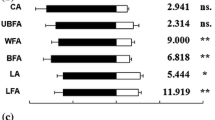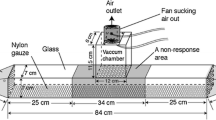Abstract
Electroantennograms were obtained fromD. pseudotsugae in response to the pheromones 3-methylcyclohex-2-en-1-one (3,2-MCHone), 3-methylcyclohex-2-en-1-ol (3,2-MCHol), frontalin,trans-verbenol, verbenone, and the host terpene hydrocarbons limonene and camphene. Male and female beetles were 10 and 100 times more sensitive to 3,2-MCH-one and 3,2-MCHol than to the other compounds. Of the other compounds, males were most sensitive totrans-verbenol, verbenone, and camphene, while females were most sensitive to frontalin, limonene, and camphene. The results parallel and help explain behavior of individual males and females during host tree selection, aggregation, and colonization.
Similar content being viewed by others
References
Alcock, J. 1981. Natural selection and communication among bark beetles.Fla. Entomol. 65:17–32.
Borden, J.H. 1977. Behavioral response of Coleoptera to pheromones, allomones, and kairomones, pp. 169–198.in H.H. Shorey and J.J. McKelvey, Jr. (eds.)Chemical Control of Insect Behavior: Theory and Application. John Wiley & Sons, New York.
Dickens, J.C. 1978. Olfactory perception of pheromone and host-odour enantiomers byIps typographus L. (Col.: Scolytidae). 4th International Insect-Host Plant Symposium.Entomol. Exp. Appl. 24:136–142.
Dickens, J.C. 1979. Electrophysiological investigations of olfaction in bark beetles.Mitt. Schweiz. Entomol. Ges. 52:203–216.
Dickens, J.C. 1981. Behavioral and electrophysiological responses of bark beetle,Ips typographus, to potential pheromone components,Physiol. Entomol. 6:251–261.
Dickens, J.C., andPayne, T.L. 1977. Bark beetle olfaction: Pheromone receptor system inDendroctonus frontalis, J. Insect Physiol. 23:481–489.
Furniss, M.M., Kline, L.N., Schmitz, R.F., andRudinsky, J.A. 1972. Tests of three pheromones to induce or disrupt aggregation of Douglas-fir beetles (Coleoptera: Scolytidae) on live trees.Ann. Entomol. Soc. Am. 65:1227–1232.
Hynum, B.G., andBerryman, A.A. 1980.Dendroctonus ponderosae (Coleoptera: Scolytidae): Pre-aggregation landing and gallery initiation on lodgepole pine.Can. Entomol. 112:185–191.
Jantz, O.K., andJohnsey, R.L. 1964. Determination of sex in the Douglas-fir beetleDendroctonus pseudotsugae Hopkins (Coleoptera: Scolytidae).Can. Entomol. 96:1327–1329.
Kinzer, G.W., Fentiman, A.F., Jr., Page, T.F., Jr., Foltz, R.L., Vité, J.P., andPitman, G.B. 1969. Bark beetle attractants: Identification, synthesis and field bioassay of a new compound isolated fromDendroctonus.Nature 221:477–488.
Kinzer, G.W., Fentiman, A.F., Jr., Foltz, R.L., andRudinsky, J.A. 1971. Bark beetle attractants: 3-Methyl-2-cyclohexen-1-one isolated fromDendroctonus pseudotsugae.J. Econ. Entomol. 64:970–971.
Libbey, L.M., Morgan, M.E., Putman, T.B., andRudinsky, J.A. 1976. Isomer of antiaggregative pheromone identified from male Douglas-fir beetle: 3-methylcyclohex-3-en-1-one.J. Insect Physiol. 22:871–873.
Moeck, H.A., Wood, D.L.,andLindahl, K.Q., Jr. 1981. Host selection behavior of bark beetles (Coleoptera: Scolytidae) attackingPinus ponderosa, with special emphasis on the western pine beetle,Dendroctonus brevicomis.J. Chem. Ecol. 7:49–83.
Ostle, B. 1969. Statistics in Research. Iowa State University Press, Ames.
Payne, T.L. 1975. Bark beetle olfaction. III. Antennal olfactory responsiveness ofDendroctonus frontalis Zimmerman andD. brevicomis Le Conte (Coleoptera: Scolytidae) to aggregation pheromones and host tree terpene hydrocarbons.J. Chem. Ecol. 1:233–242.
Pitman, G.B., andVité, J.P. 1970. Field response ofDendroctonus pseudotsugae (Coleoptera: Scolytidae) to synthetic frontalin.Ann. Entomol. Soc. Am. 63:661–664.
Rudinsky, J.A. 1966. Scolytid beetles associated with Douglas-fir: Response to terpenes.Science 152:218–219.
Rudinsky, J.A. 1969. Masking of the aggregation pheromone inDendroctonus pseudotsugae Hopk.Science 166:884–885.
Rudinsky, J.A. 1973. Multiple functions of the Douglas-fir beetle pheromone 3-methyl-2-cyclohexen-1-one.Environ. Entomol. 2:579–585.
Rudinsky, J.A. andMichael, R.R. 1972. Sound production in Scolytidae: Chemostimulus of sonic signal by the Douglas-fir beetle.Science 175:1386–1390.
Rudinsky, J.A. andRyker, L.C. 1976. Sound production in Scolytidae: Rivalry and premating stridulation of male Douglas-fir beetle.J. Insect Physiol. 22:997–1003.
Rudinsky, J.A., andRyker, L.C. 1977. Olfactory and auditory signals mediating behavioral patterns of bark beetles.Colloq. Int. C.N.R.S. 265:195–209.
Rudinsky, J.A., Furniss, M.M., Kline, L.N., andScmitz, R.F. 1972a. Attraction and repression ofDendroctonus pseudotsugae (Coleoptera: Scolytidae) by three synthetic pheromones in traps in Oregon and Idaho.Can. Entomol. 104:815–822.
Rudinsky, J.A., Kinzer, G.W., Fentiman, A.F., Jr., andFoltz, R.L. 1972b.trans-Verbenol isolated from Douglas-fir beetle: Laboratory and field bioassays in Oregon.Environ. Entomol 1:485–488.
Rudinsky, J.A., Morgan, M.E., Libbey, L.M., andPutman, T.B. 1974. Additional components of the Douglas-fir beetle (Col.: Scolytidae) aggregation pheromone and their possible utility in pest control.Z. Angew. Entomol. 76:65–77.
Rudinsky, J.A., Ryker, L.C., Michael, R.R., Libbey, L.M., andMorgan, M.E. 1976a. Sound production in Scolytidae: Female sonic stimulus of male pheromone release in twoDendroctonus beetles.J. Insect Physiol. 22:1675–1681.
Rudinsky, J.A., Morgan, M.E., Libbey, L.M., andPutman, T.B. 1976b. Release of frontalin by male Douglas-fir beetle.Z. Angew. Entomol. 81:267–269.
Rudinsky, J.A., Morgan, M.E., Libbey, L.M., andPutman, T.B. 1977. Limonene released by the scolytid beetleDendroctonus pseudotsugae.Z. Angew. Entomol. 82:376–380.
Ryker, L.C., Libbey, L.M., andRudinsky, J.A. 1979. Comparison of volatile compounds and stridulation emitted by the Douglas-fir beetle from Idaho and western Oregon populations.Environ. Entomol. 8:789–798.
Schneider, D. 1957. Elektrophysiologische Untersuchungen von Chemo- und Mechanorezeptoren der Antenne des SeidenspinnersBombyx mori.Z. Vergl. Physiol. 40:8–41.
Vité, J.P., andFrancke, W. 1976. The aggregation pheromones of bark beetles: Progress and problems.Naturwissenschaften 63:550–555.
Vité, J.P., Pitman, G.B., Fentiman, A.F., Jr., andKinzer, G.W. 1972. 3-Methyl-2-cyclohexen-1-ol isolated fromDendroctonus.Naturwissenschaften 59:469.
Author information
Authors and Affiliations
Additional information
Texas Agricultural Experiment Station Paper Number TA-17779. This research was supported in part by McIntire-Stennis Project 1525, and NSF Grant PCN 79-21708 to Oregon State University. All programs and information of the Texas Agrigultural Experiment Station are available without regard to race, ethnic origin, religion, sex, or age.
Rights and permissions
About this article
Cite this article
Dickens, J.C., Gutmann, A., Payne, T.L. et al. Antennal olfactory responsiveness of Douglas-fir beetle,Dendroctonus pseudotsugae Hopkins (Coleoptera: Scolytidae) to pheromones and host odors. J Chem Ecol 9, 1383–1395 (1983). https://doi.org/10.1007/BF00990745
Received:
Revised:
Issue Date:
DOI: https://doi.org/10.1007/BF00990745




